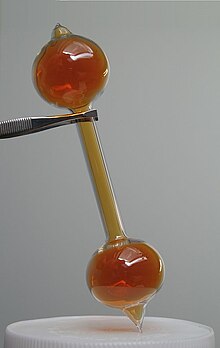
In physics, a vapor (American English) or vapour (Commonwealth English; see spelling differences) is a substance in the gas phase at a temperature lower than its critical temperature,[1] which means that the vapor can be condensed to a liquid by increasing the pressure on it without reducing the temperature of the vapor. A vapor is different from an aerosol.[2] An aerosol is a suspension of tiny particles of liquid, solid, or both within a gas.[2]
For example, water has a critical temperature of 647 K (374 °C; 705 °F), which is the highest temperature at which liquid water can exist at any pressure. In the atmosphere at ordinary temperatures gaseous water (known as water vapor) will condense into a liquid if its partial pressure is increased sufficiently.
A vapor may co-exist with a liquid (or a solid). When this is true, the two phases will be in equilibrium, and the gas-partial pressure will be equal to the equilibrium vapor pressure of the liquid (or solid).[1]
- ^ a b R. H. Petrucci, W. S. Harwood, and F. G. Herring, General Chemistry, Prentice-Hall, 8th ed. 2002, p. 483–86.
- ^ a b Cheng, T. (2014). "Chemical evaluation of electronic cigarettes". Tobacco Control. 23 (Supplement 2): ii11–ii17. doi:10.1136/tobaccocontrol-2013-051482. ISSN 0964-4563. PMC 3995255. PMID 24732157.